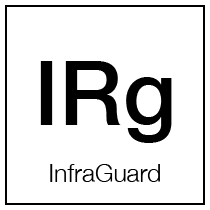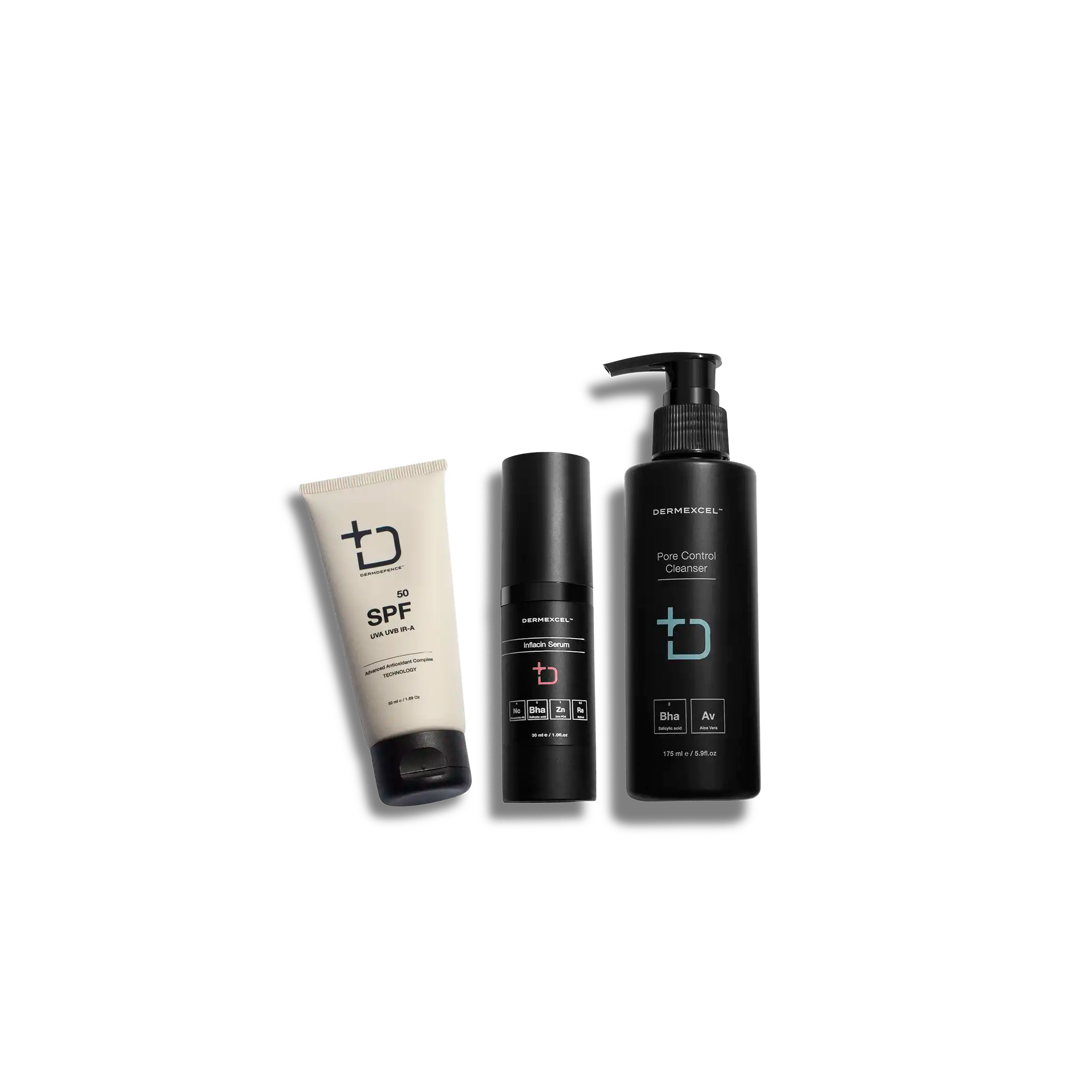

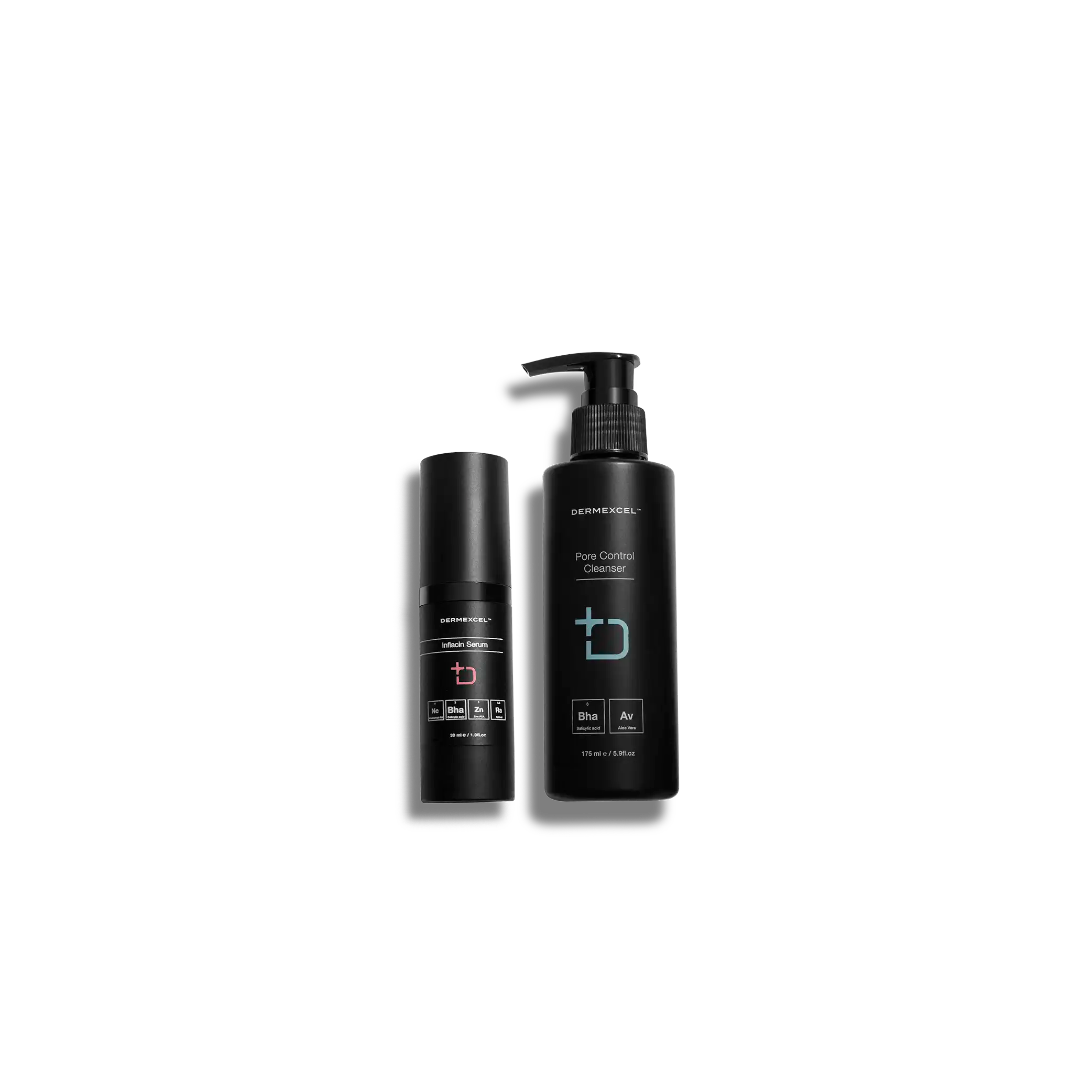




Treatment pack for pre-teens / tweens with congested pores and/or breakouts.
Products included
Free Gifts with your treatment pack

Microfibre Sponge

Cotton Bag




SHIPPING
- Shipping Guarantee: Guiding you to healthy skin isn’t only about our products; it's also about getting them to you as swiftly as the science behind them. That's why Dermal Health offers a shipping guarantee you can rely on.
- Where We Ship From: Orders are dispatched from our facilities in Pretoria.
- Who We Ship With: We trust only well-known, popular, and dependable courier services with your packages.
- When You'll Get It: Expect confident skin soon! Shipping addresses in Pretoria and Johannesburg will enjoy delivery from same-day to 2 business days. Shipping addresses further from Pretoria may expect delivery within 1-4 business days, depending on the service you select during checkout. Your estimated delivery date will reflect during checkout so that you can mark your calendar.
- Tracking Your Order: Eager to start your DermExcel journey? We don't blame you! You'll receive a tracking number after you place your order so that you can follow your package.
For any shipping inquiries, our customer service team is ready to assist.
RETURNS
Dermal Health Science 30-Day Confidence Guarantee: We are passionate about guiding you to healthy skin through medical science. We believe in the quality and effectiveness of our products so much that we offer a 30-Day Confidence Guarantee.
If you're unsatisfied with your purchase, simply return it within 30 days for a full refund.
Healthy Skin Is Not Complicated and neither is our return policy. Please visit our detailed return policy or contact our friendly customer service team for more information.
Feel as confident in us as we want you to feel in your skin.
SECURE PAYMENT
Dermal Health Science 30-Day Confidence Guarantee: We are passionate about guiding you to healthy skin through medical science. We believe in the quality and effectiveness of our products so much that we offer a 30-Day Confidence Guarantee.
If you're unsatisfied with your purchase, simply return it within 30 days for a full refund.
Healthy Skin Is Not Complicated and neither is our return policy. Please visit our detailed return policy or contact our friendly customer service team for more information.
Feel as confident in us as we want you to feel in your skin.

Choose options



Treatment pack for pre-teens / tweens with congested pores and/or breakouts.
MORNING
EVENING
MORNING
EVENING
Morning Regimen Notes
For the best use of Pore Control Cleanser, please check the detailed instructions on its product page. You can access this page by clicking the cleanser's name above.
Apply Dermdefence SPF 50 after cleansing.
Evening Regimen Notes
For the best use of Pore Control Cleanser, please check the detailed instructions on its product page. You can access this page by clicking the cleanser's name above.
Apply Inflacin Serum in the evening after cleansing on dry skin.
Important Notes
- Reduce Inflacin Serum application frequency to 1-2 times per week.
- When irritation subsides, slowly increase the frequency of Inflacin Serum application again as your skin tolerates it.
DermExcel™ treatment for Congested Skin in Pre-Teens offers a gentle, effective solution for managing early signs of pore blockage, commonly caused by hormonal shifts that increase oil production. These changes can lead to blackheads and whiteheads as pores become clogged with excess sebum and dead skin cells. DermExcel™ focuses on deep yet non-stripping cleansing and introduces key ingredients like salicylic acid to help clear buildup inside the pores. With a simple, consistent routine—including proper cleansing, light exfoliation, and hydration—pre-teens can develop healthy skincare habits that support clear, balanced skin and growing confidence.
your frustrations
- Congested pores: Comedones in the form of blackheads and whiteheads.
- Texture: Rough skin texture with an altered microbiome.
- Misinformation: With internet and social media access, tweens might follow skincare advice that is inappropriate or damaging for their skin type, leading to frustration when these methods do not work or worsen their skin condition.
- Self-Esteem: Even minor skin issues can have a significant impact on self-confidence.
- Maintaining Consistency: Sticking to a skincare routine can be challenging, especially if you adjust to new responsibilities. Skipping skincare steps due to a busy schedule or lack of interest can lead to changes in skin health.
- Sensitive Skin: Your skin may be sensitive and react negatively to harsh skincare products, environmental factors, and physical or emotional stress.
your goals
- Improved texture: Smooth skin texture with clean pores.
- Clear Skin: Skin clear of acne and blemishes.
- Develop Healthy Skincare Habits: Establishing a simple, effective skincare routine that sets the foundation for skin care into the teenage years and beyond.
- Education About Skin Changes: Insight on skin changes and how to adjust your skincare regimen accordingly.
- Prevent Skin Damage: Consistent sun protection to prevent future skin damage, such as sunburns or premature aging, is a proactive skincare goal.
- Boost Self-Esteem: Maintaining healthy skin can help improve self-esteem, and make you feel more confident in your appearance.

↑ Elasticity

Natural Oils

↑ Collagen

Faster Healing
-
Elastic skin: The skin at this age is naturally more elastic due to a higher concentration of elastin fibers. This elasticity allows the skin to withstand environmental stress and repair itself quickly, reducing the likelihood of long-term damage from congestion.
-
Tween skin’s natural oils, hydration, and elasticity create a barrier against environmental stressors like pollution and bacteria. Even with congested pores, this resilience allows the skin to recover from external damage better than older skin.
-
Tween and pre-teen skin has higher collagen levels, contributing to its plumpness, elasticity, and faster repair. Even if pores are congested, the skin can often bounce back quickly and heal well without long-term damage, as collagen promotes a youthful, resilient complexion.
-
Pre-teen skin can heal more quickly from minor injuries, including blemishes from congested pores. This rapid healing minimizes the risk of scarring and allows for a quicker recovery from breakouts or irritation.

≈ Hormones

↑ Sebum

↓ cell turnover

Thicker Skin
-
During puberty, increased levels of androgens (such as testosterone) stimulate sebaceous glands, causing them to produce excess sebum (oil). This overproduction can lead to clogged pores and congestion.
-
The sebaceous glands in tween skin are more active during this stage, producing more oil than necessary. The excess oil combines with dead skin cells, clogging pores and creating an ideal environment for congestion.
-
Skin cell turnover can slow down or become irregular during this developmental stage, accumulating dead skin cells on the surface. These dead cells block the pores and trap oil and bacteria, worsening congestion.
-
Tween and pre-teen skin tends to be thicker due to higher levels of collagen and elastin production. This can make pores appear smaller but deeper, increasing the likelihood of pore blockages as oil and debris get trapped.
-
Tweens can experience hyperkeratinization, where the skin produces too much keratin, a protein that binds dead skin cells together. This excess keratin can clog hair follicles, leading to conditions like keratosis pilaris, or acne.
-
Increased activity of sweat glands can mix with sebum and dead skin cells, contributing to pore congestion. Excess sweating can lead to blockages if sweat is not properly cleansed from the skin.
include
- Anti-inflammatory and anti-microbial agents.
- Pore decongesting and sebum regulating agents.
- Broad spectrum sunscreen with antioxidants - preventing premature aging and DNA damage.
- Chemical exfoliators to accelerate in-pore exfoliation.
- Skin-identical medical-grade ingredients penetrating the skin to activate a biological response.
avoid
- Damaging lifestyle habits, e.g. smoking, tanning beds, excessive sun and sugar consumption.
- Toners and foaming cleansers containing soap & sulfates.
- Fragrance in skincare products.
- Harsh anti-bacterial products that disrupt the skin's natural microbiome.
- Irritating plant extracts and essential oils that will trigger sebum production and secretion.
Pre-teen / Tween with Congested Pores
Treatment Objectives

Support Healthy Skin Renewal
Adolescence is a time of rapid skin cell turnover. This treatment aims to support this process, promoting a fresh, youthful appearance.

Balance Oil Production
For tweens who are starting to see an increase in oil production, treatment aims to gently balance this to prevent clogged pores and early breakouts.

Sun Damage Protection
Protect against harmful UV rays, preventing sun damage and encouraging the habit of daily sunscreen application.

Control Early Breakouts
As tweens approach puberty, they may begin to experience their first breakouts. The treatment aims to prevent and control these early instances of acne.

Unclog pores
Dissolve and extract cellular debris and prevent skin cells from clumping together in pores to ensure that the pores remain clear and free from blockages, which can lead to breakouts.

Soothe Skin Irritations
Soothe common skin irritations, including minor rashes or sensitivity, which tweens may experience due to environmental factors or the onset of hormonal changes.
Pre-teen / Tween with Congested Pores
active ingredients your skin needs
Retinoic acid analogue
Retinoic acid, often referred to as tretinoin in its pharmaceutical form, is the active form of Vitamin A. It is widely recognized for its powerful effects in dermatology and skin care, particularly in treating acne and signs of skin aging.
Retinoic acid works at the cellular level to modify gene expression and affect cell growth. In treating acne, it promotes the turnover of skin cells, reducing the likelihood of pore-clogging and helping to clear existing breakouts. Additionally, it decreases the cohesiveness of follicular epithelial cells, further preventing the formation of comedones.
Retinoic acid's ability to stimulate collagen production is a key benefit in anti-aging skincare. This leads to a reduction in fine lines and wrinkles and an improvement in overall skin texture and tone. It also aids skin discoloration and hyperpigmentation by accelerating cell turnover, bringing new skin cells to the surface faster, and shedding pigmented and damaged cells.
Despite its benefits, retinoic acid can irritate the skin, causing side effects like redness, dryness, and peeling, especially during the initial period of use. Its potency means it is generally available by prescription and requires careful monitoring by a healthcare professional.
Hydroxypinacolone Retinoate (HPR) is a newer, esterified form of retinoic acid. Unlike cosmetic retinol, HPR binds directly to the retinoid receptors of the skin cells without needing conversion. This direct binding allows it to deliver similar benefits to retinoic acid, such as stimulating collagen production, improving skin elasticity, and reducing signs of aging, but with a lower risk of irritation.
HPR is considered more gentle and less irritating than traditional retinoic acid while offering comparable benefits. With HPR, everyone has access to the benefits of prescription retinoids without the risk of side effects.
Physiological Effects
- Cell Turnover and Renewal: HPR promotes rapid cell turnover, aiding in the exfoliation of dead skin cells and generating new cells.
- Skin Texture: Promoting cell renewal improves skin texture and addresses issues like roughness and dullness.
- Collagen Production: It stimulates collagen production, which is essential for reducing the appearance of fine lines and wrinkles and improving skin elasticity.
- Acne Treatment: Effective in treating acne by unclogging pores and reducing the size of sebaceous glands, it diminishes both inflammatory and non-inflammatory acne lesions.
- Pigmentation: It can reduce hyperpigmentation by accelerating the turnover of hyperpigmented skin cells and inhibiting melanin production.
- Photoaging: Effective in treating signs of photoaging, reversing some of the damage caused by UV radiation.
Special Benefits
- Retinoid Receptor Activity: HPR, an ester of retinoic acid, binds directly to retinoid receptors in the skin, enabling it to work without needing to be converted into retinoic acid.
- Lower Irritation: Typically, it causes less irritation than retinoic acid, making it more suitable for sensitive skin types.
- Collagen Stimulation and Anti-Aging: Like retinoic acid, HPR helps in stimulating collagen production and has anti-aging properties.
- Acne and Hyperpigmentation: It effectively treats acne and reduces hyperpigmentation, often with fewer side effects than retinoic acid.
- Stability and Penetration: HPR is more stable and lipid-soluble, so it penetrates the skin more effectively and is less prone to degradation.
References
- Zaenglein, A. L., Pathy, A. L., Schlosser, B. J., Alikhan, A., Baldwin, H. E., Berson, D. S., ... & Thiboutot, D. M. (2016). Guidelines of care for the management of acne vulgaris. Journal of the American Academy of Dermatology, 74(5), 945-973.e33.
- Fisher, G. J., Wang, Z. Q., Datta, S. C., Varani, J., Kang, S., & Voorhees, J. J. (1996). Pathophysiology of premature skin aging induced by ultraviolet light. New England Journal of Medicine, 337(20), 1419-1428.
- Truchuelo, M. T., Jiménez, N., Jaén, P. (2018). Assessment of the efficacy of a new complex-based retinoic acid and retinol in a 3-month study using objective methods and skin biomarker analysis. Journal of Cosmetic Dermatology, 17(3), 347-354.
- Mukherjee, S., et al. (2006). Retinoids in the treatment of skin aging: an overview of clinical efficacy and safety. Clinical Interventions in Aging.
- Randhawa, M., et al. (2015). Hydroxypinacolone retinoate: a new retinoid and its use in dermatology. Skin Therapy Letter.
Salicylic acid
Salicylic acid, a renowned beta hydroxy acid (BHA), is a cornerstone in dermatology and skincare due to its exceptional keratolytic and comedolytic properties. Its unique ability to penetrate oil-laden hair follicle pores makes it particularly effective in treating acne-prone and oily skin types.
Salicylic acid dissolves skin debris (sebum and dead skin cells) that clogs pores and causes acne. It's a mild antibacterial and powerful anti-inflammatory agent that helps reduce the redness and swelling associated with breakouts.
What sets salicylic acid apart in dermatological treatments is its ability to exfoliate the skin, not just on the surface but within the pores themselves. This is due to its oil-soluble nature, which allows it to penetrate deep into the pores and dissolve the keratin plugs that lead to blackheads and whiteheads.
Furthermore, salicylic acid also has the capacity to adjust the pH of the skin, creating an environment less favorable for the growth of acne-causing bacteria. Salicylic acid's efficacy in treating various skin conditions, particularly acne, has been extensively documented in the scientific literature. Studies have consistently shown its ability to reduce acne lesions in terms of count and severity. Additionally, salicylic acid is highly recommended for its effectiveness in treating other skin conditions, such as psoriasis and dandruff, due to its ability to soften and remove scales and flakes from the skin.
Physiological Effects
- Keratolytic Action: Salicylic acid is known for its ability to exfoliate the skin by dissolving the intercellular 'glue' that holds skin cells together, helping to remove dead skin cells and unclog pores.
- Comedolytic Effect: It is particularly effective in reducing comedones (blackheads and whiteheads) by unclogging pores and preventing the formation of new comedones.
- Anti-inflammatory Properties: Salicylic acid reduces inflammation, which is beneficial in treating acne and other inflammatory skin conditions.
- Sebum Regulation: It helps to regulate oil production, making it a valuable ingredient for managing oily and acne-prone skin.
- Penetration Enhancement: Due to its lipophilic nature, it can penetrate sebum-filled follicles, effectively treating acne located deep within the pores.
Managing Dermatological Conditions
- Acne Vulgaris: Salicylic acid is a cornerstone in acne treatment, effectively preventing and treating existing acne lesions.
- Psoriasis: Its keratolytic properties make it helpful in softening and removing scales associated with psoriasis.
- Warts: Salicylic acid is commonly used to treat warts because it can exfoliate and remove thick skin.
- Seborrheic Dermatitis: It helps manage seborrheic dermatitis by reducing scaling and redness.
- Keratosis Pilaris: Salicylic acid can aid in smoothing the rough bumps associated with peratosis Pilaris.
References
- Zaenglein, A. L., Pathy, A. L., Schlosser, B. J., Alikhan, A., Baldwin, H. E., Berson, D. S., & Thiboutot, D. M. (2016). Guidelines of care for the management of acne vulgaris. Journal of the American Academy of Dermatology, 74(5), 945-973.e33.
- Kornhauser, A., Coelho, S. G., & Hearing, V. J. (2010). Applications of hydroxy acids: classification, mechanisms, and photoactivity. Clinical, cosmetic and investigational dermatology, 3, 135.
- Zander, E., & Weisman, S. (1992). Treatment of acne vulgaris with salicylic acid pads. Clinical Therapeutics.
- Gupta, A. K., & Nicol, K. (2004). The use of sulfur in dermatology. Journal of Drugs in Dermatology.
Niacinamide
Niacinamide offers several benefits for the skin, primarily due to its anti-inflammatory and antioxidant properties. It reduces the redness and inflammation associated with acne, rosacea, and other inflammatory skin conditions. Additionally, niacinamide's ability to improve the skin's barrier function benefits all skin types, particularly those with eczema or mature skin.
Another significant benefit of niacinamide is its role in reducing hyperpigmentation. Studies have shown that it can decrease the transfer of melanin to the epidermis, helping to fade dark spots and even out skin tone.
Niacinamide also plays a role in reducing the visible signs of aging. It has been found to stimulate collagen production and improve skin elasticity, reducing fine lines and wrinkles. Its antioxidant properties further protect the skin from environmental damage, such as pollution and UV radiation, which contribute to premature aging.
The efficacy of niacinamide and its ability to address multiple skin concerns simultaneously has led to its growing popularity in both over-the-counter and prescription skincare formulations.
Physiological Effects
- Barrier Function Enhancement: Niacinamide helps strengthen the skin’s barrier function by increasing the production of ceramides, lipids that keep the skin hydrated and protect against environmental damage.
- Anti-inflammatory Properties: It has notable anti-inflammatory effects, which are beneficial in reducing redness and inflammation associated with acne, eczema, and other inflammatory skin conditions.
- Sebum Regulation: Niacinamide helps regulate sebum production, which controls excess oiliness and can benefit acne-prone skin.
- Hyperpigmentation Reduction: It reduces hyperpigmentation by inhibiting melanosome transfer from melanocytes to keratinocytes, leading to an even skin tone.
- Anti-aging Effects: Niacinamide helps reduce the appearance of fine lines and wrinkles by boosting collagen production and improving skin elasticity.
- Antioxidant Activity: It has antioxidant properties, protecting the skin from oxidative stress and environmental aggressors like UV radiation and pollution.
Managing Dermatological Conditions
- Acne and Oily Skin: Niacinamide effectively manages acne and oily skin by regulating sebum and reducing inflammation.
- Hyperpigmentation and Melasma: Its ability to reduce melanin transfer benefits it in treating hyperpigmentation and melasma.
- Aging Skin: Niacinamide targets wrinkles and loss of firmness.
- Skin Barrier Disorders: Niacinamide is beneficial in treating skin barrier disorders like atopic dermatitis and eczema by enhancing barrier function and hydration.
- Photodamage and Skin Protection: It helps mitigate the effects of photodamage and provides some degree of protection against environmental damage.
References
- Gehring, W. (2004). Nicotinic acid/niacinamide and the skin. Journal of Cosmetic Dermatology.
- Bissett, D. L., Oblong, J. E., & Berge, C. A. (2005). Niacinamide: A B vitamin that improves aging facial skin appearance. Dermatologic Surgery.
- Snaidr, V. A., Damian, D. L., & Halliday, G. M. (2019). Nicotinamide for photoprotection and skin cancer chemoprevention: A review of efficacy and safety. Experimental Dermatology.
- Navarrete-Solís, J. et al. (2011). A Double-Blind, Randomized Clinical Trial of Niacinamide 4% versus Hydroquinone 4% in the Treatment of Melasma. Dermatology Research and Practice, 2011.
Aloe Vera
Aloe vera is well-regarded for its medicinal applications and has been a staple in skincare and health for centuries. It’s rich in vitamins, enzymes, minerals, and amino acids, contributing to its many skin benefits.
Aloe vera contains polysaccharides, which are crucial in its moisturizing and anti-inflammatory properties. These polysaccharides help bind moisture to the skin, making aloe vera an excellent hydrating agent for dry and damaged skin.
One of the key benefits of aloe vera is its soothing and healing properties, particularly beneficial for burns, abrasions, and skin irritations. It has been shown to accelerate the healing of minor burns and reduce skin inflammation. Various studies have supported its effectiveness in treating first- and second-degree burns, highlighting its role in enhancing collagen synthesis and skin regeneration.
Aloe vera's anti-inflammatory properties are attributed to compounds like glycoproteins and polysaccharides. These compounds help reduce pain and swelling associated with skin irritations and wounds. Aloe vera also contains aloin and emodin, which provide analgesic, antibacterial, and antiviral properties, further extending its therapeutic potential.
Aloe Vera has numerous physiological effects on the skin due to its rich composition of vitamins, enzymes, minerals, and amino acids. The presence of antioxidants such as vitamins C and E, along with beta-carotene, contributes to its anti-aging benefits, helping to improve skin firmness and keep the skin hydrated.
Physiological Effects
- Moisturizing and Hydrating: Aloe Vera enhances skin hydration, making it effective for dry and dehydrated skin. Its mucopolysaccharides help to bind moisture into the skin.
- Wound Healing: It accelerates wound healing by enhancing collagen synthesis and cross-linking. This effect is particularly useful in healing burns, abrasions, and cuts.
- Anti-inflammatory Properties: Aloe Vera contains compounds like aloin and anthraquinones that have anti-inflammatory properties, making it beneficial in reducing skin inflammation.
- Antimicrobial Activity: It possesses antimicrobial properties, which help in preventing infections in wounds and burns.
- Antioxidant Properties: The presence of vitamins C and E and beta-carotene provides it with antioxidant properties, which can help protect the skin from free radical damage.
- Soothing Effect: Aloe Vera is known for its soothing effects on the skin, particularly in conditions like sunburn.
Managing Dermatological Conditions
- Burns and Wound Care: Aloe Vera's wound-healing and soothing properties make it effective in treating burns, including sunburns and minor skin abrasions.
- Acne Treatment: Due to its antimicrobial and anti-inflammatory properties, it can help treat acne.
- Eczema and Psoriasis: Its moisturizing, anti-inflammatory, and soothing properties are beneficial in managing symptoms of eczema and psoriasis.
- Aging Skin: Aloe Vera's antioxidant properties and ability to improve collagen production can help reduce the signs of aging.
- Skin Hydration: It's a common ingredient in moisturizers and other skin care products for its hydrating properties.
References
- Surjushe, A., Vasani, R., & Saple, D. G. (2008). Aloe vera: A short review. Indian Journal of Dermatology.
- Maenthaisong, R., Chaiyakunapruk, N., Niruntraporn, S., & Kongkaew, C. (2007). The efficacy of aloe vera used for burn wound healing: A systematic review. Burns.
- Rajeswari, R., Umadevi, M., Rahale, C. S., Pushpa, R., Selvavenkadesh, S., Kumar, K. S., & Bhowmik, D. (2012). Aloe vera: The miracle plant its medicinal and traditional uses in India. Journal of Pharmacognosy and Phytochemistry.
Zinc PCA
Zinc PCA, also known as Zinc Pyrrolidone Carboxylic Acid, is a skin care ingredient that combines the mineral zinc with a hydrating molecule PCA (Pyrrolidone Carboxylic Acid). It is renowned for its numerous benefits in skincare, particularly for its anti-inflammatory, antimicrobial, and sebum-regulating properties.
Zinc PCA is derived from zinc, an essential mineral known for its antioxidant and skin-soothing capabilities. Zinc is also noted for its role in wound healing and its ability to reduce inflammation, which can be particularly beneficial for acne-prone and irritated skin. The PCA component is a natural moisturizing factor (NMF) found in the skin, which helps maintain the skin's hydration levels.
One of the key benefits of Zinc PCA is its ability to regulate sebum production. Excess sebum can lead to acne and oily skin, and Zinc PCA helps to moderate this by inhibiting the activity of the enzyme 5-alpha reductase, which is involved in oil production. This makes it an effective ingredient in formulations targeting oily and acne-prone skin (Schueller, R. and Romanowski, P., 2003).
In addition to its sebum-regulating properties, Zinc PCA possesses antimicrobial properties, which further contribute to its efficacy in treating acne. By reducing the presence of acne-causing bacteria on the skin, it helps to prevent and reduce acne breakouts.
Moreover, Zinc PCA's anti-inflammatory properties make it beneficial for soothing irritated skin and reducing redness and inflammation associated with various skin conditions, including acne, rosacea, and eczema.
Physiological Effects
- Sebum Regulation: Zinc PCA reduce and regulate sebum secretion and production, making it beneficial for oily and acne-prone skin by controlling excess oil production.
- Antimicrobial Action: Zinc has antimicrobial properties, particularly effective against acne-causing bacteria, reducing acne breakouts.
- Anti-inflammatory Effects: Zinc PCA reduces inflammation, which is beneficial in treating inflammatory skin conditions like acne and rosacea.
- Moisture Retention: PCA is a natural moisturizing factor (NMF) that helps maintain skin hydration, enhancing the skin’s moisture retention capabilities.
- Wound Healing: Zinc is essential for wound healing processes, aiding in the repair and regeneration of skin tissues.
Managing Dermatological Conditions
- Acne Management: Its ability to regulate sebum production and provide antimicrobial action makes Zinc PCA a valuable ingredient in acne treatments.
- Oily Skin: It's beneficial in controlling excess oiliness and maintaining a balanced skin environment.
- Sensitive Skin Conditions: Due to its anti-inflammatory properties, Zinc PCA soothes sensitive skin and conditions like rosacea.
- Skin Hydration: Its role as an NMF helps in maintaining skin hydration, useful in treating dry skin conditions.
References
- Schagen, S. K., et al. (2012). Discovering the link between nutrition and skin aging. Dermato-endocrinology.
- Firooz, A., et al. (2011). Zinc therapy in dermatology: a review. Dermatology Research and Practice.
- Gupta, M., et al. (2014). Zinc therapy in dermatology. Indian Dermatology Online Journal.
- Schueller, R. and Romanowski, P. (2003). Conditioning Agents for Hair and Skin. Cosmetic Science and Technology Series. Marcel Dekker Inc., New York, USA.
Infraguard™
Infraguard™ is a novel and powerful antioxidant powerhouse designed to protect the skin from the potentially harmful effects of electromagnetic radiation, specifically from 5G networks, blue light, and other environmental stressors. It shields the skin against oxidative stress and inflammation, prevents premature aging, and maintains overall health.
Infraguard® is a multifunctional ingredient that extends beyond traditional sun protection. It addresses the broader spectrum of light-induced skin damage and oxidative stress, provides DNA protection, and offers anti-aging benefits. Its inclusion in the DermExcel sunscreens represents an advanced step in comprehensive skin care, targeting UV rays and the often-overlooked infrared and blue light, ensuring a more holistic approach to maintaining skin health and appearance.
Physiological Effects
- Protection Against Blue Light and Infrared (IR) Radiation: Infraguard is formulated to shield the skin from the harmful effects of blue light and IR radiation, which can lead to premature skin aging and damage.
- Antioxidant Properties: It has strong antioxidant capabilities, helping to neutralize free radicals induced by environmental stressors such as pollution, IR, and blue light.
- Anti-Aging Benefits: By protecting against IR radiation and mitigating oxidative stress, Infraguard helps to prevent signs of aging like wrinkles and loss of skin elasticity.
- Skin Barrier Protection: Infraguard strengthens the skin's natural barrier, enhancing its resilience against environmental factors.
- DNA Protection: Infraguard™ aids in shielding the DNA in skin cells from damage caused by environmental aggressors. This is crucial in maintaining the integrity of skin cells and preventing mutations that can lead to skin aging and other skin-related issues.
Managing Dermatological Conditions
- Preventing Photoaging: Infraguard's ability to protect against IR and blue light makes it beneficial in preventing photoaging, a key concern in modern dermatology. Infrared light can penetrate deeper into the skin than UV rays, potentially leading to increased collagen degradation and skin laxity. Infraguard® helps mitigate these effects.
- Combatting Environmental Stressors: Its antioxidant properties protect the skin from various environmental pollutants and stressors.
- Supporting Skin Health: Infraguard contributes to overall skin health by improving the skin's barrier function and providing antioxidant support.
- Suitability for Diverse Skin Conditions: Given its protective and anti-aging properties, Infraguard is suitable for use in various dermatological conditions, especially environmental damage and aging.
References
- Kappler, Katharina et al. "Development of an in Vitro Assay to Evaluate the Biological Impact of 5G Technology on Human Skin. Journal of Cosmetics, Dermatological Sciences and Applications, 2022, vol. 12, pp. 100-108. DOI: 10.4236/jcdsa.2022.122009.
- Extensive references cited within the research article including studies on 5G technology, health effects, and skin biology.
Humectants
Humectants are a vital component in skincare, particularly for conditions characterized by impaired skin barrier function and excessive dryness. Their ability to attract and retain moisture in the skin makes them invaluable in both therapeutic and preventive dermatology.
Physiological Effects
- Moisture Attraction: Humectants draw moisture from the environment and the deeper layers of the skin to the outer layer (stratum corneum), enhancing skin hydration.
- Enhancing Skin Barrier Function: By improving skin hydration, humectants help to maintain and improve the skin's barrier function, protecting against irritants and reducing transepidermal water loss (TEWL).
- Skin Elasticity and Appearance: Improved hydration can enhance skin elasticity and reduce the appearance of fine lines and wrinkles, giving the skin a plumper and smoother look.
- Soothing Effect: Humectants can have a soothing effect on the skin, particularly in conditions involving dryness or irritation.
Managing Dermatological Conditions
- Dry Skin (Xerosis): Humectants are key ingredients in many moisturizers and are highly effective in managing dry skin by providing and maintaining hydration.
- Eczema and Dermatitis: Their moisturizing and soothing properties help in relieving symptoms of eczema and dermatitis, such as dryness, itching, and irritation.
- Aging Skin: Humectants are used in anti-aging skincare products due to their ability to hydrate the skin and improve its appearance.
- Psoriasis: They can aid in reducing the dryness and scaling associated with psoriasis.
- Acne-Prone Skin: Certain humectants can be beneficial in acne treatments, as they provide necessary hydration without clogging pores.
References
- Lodén, M. (2005). Role of Topical Emollients and Moisturizers in the Treatment of Dry Skin Barrier Disorders. American Journal of Clinical Dermatology.
- Rawlings, A. V., & Canestrari, D. A. (2011). Moisturizer technology versus clinical performance. Dermatologic Therapy.
- Fluhr, J. W., Darlenski, R., & Surber, C. (2008). Glycerol and the skin: holistic approach to its origin and functions. British Journal of Dermatology.
Emollients
Emollients are crucial in dermatological care, primarily because they enhance skin hydration and barrier function. Here's a brief overview of their physiological effects and roles in managing various skin conditions.
Physiological Effects
- Hydration of Stratum Corneum: Emollients increase moisture content in the stratum corneum, the outermost layer of the skin, by reducing transepidermal water loss (TEWL). This is achieved through occlusion, which traps water in the skin.
- Restoration of Skin Barrier Function: They aid in replenishing the skin's lipid barrier, which is essential for maintaining skin integrity and protective function.
- Soothing and Smoothing Effects: Emollients smooth, flaky skin cells, making the skin surface appear smoother. They also provide a soothing effect, which can reduce itching and discomfort.
- Anti-inflammatory Properties: Some emollients have ingredients that offer mild anti-inflammatory benefits, helping to reduce redness and irritation.
Managing Dermatological Conditions
- Atopic Dermatitis (Eczema): Emollients are a cornerstone in the management of eczema, helping to maintain skin hydration, reduce flare-ups, and minimize the need for topical corticosteroids.
- Psoriasis: Regular use of emollients can reduce scaling and dryness associated with psoriasis, improving the efficacy of other topical treatments.
- Ichthyosis and Xerosis: These conditions, characterized by dry, scaly skin, benefit significantly from emollients, which help hydrate and soften the skin.
- Aging Skin: Emollients improve the appearance of aging skin by hydrating and reducing the visibility of fine lines and wrinkles.
- Skin Protection: Emollients can protect the skin from irritation and breakdown in individuals with incontinence or those who are bedridden.
References
- Proksch, E., & Lachapelle, J. M. (2005). The Management of Dry Skin with Topical Emollients. American Journal of Clinical Dermatology.
- Lynde, C. W. (2001). Moisturizers: What They Are and a Practical Approach to Product Selection. Skin Therapy Letter.
- Lodén, M. (2003). Role of Topical Emollients and Moisturizers in the Treatment of Dry Skin Barrier Disorders. American Journal of Clinical Dermatology.
Vitamin E
The fat-soluble Vitamin E's benefits in maintaining skin health and appearance are well-acknowledged in both cosmetic and clinical dermatology. Comprising a group of eight compounds, including four tocopherols and four tocotrienols, Vitamin E is known for its role in protecting cell membranes from oxidative damage.
Vitamin E is celebrated in skincare for its ability to neutralize free radicals caused by environmental stressors such as UV radiation and pollution. These free radicals can lead to premature skin aging, making Vitamin E a valuable ingredient in anti-aging skincare products. Its antioxidant action helps to protect the skin from damage, reduce the appearance of wrinkles, and improve skin texture and tone.
Additionally, Vitamin E is known for its moisturizing benefits. It helps to strengthen the skin barrier, reduce moisture loss, and keep the skin hydrated and supple. This makes it especially beneficial for dry and damaged skin.
Vitamin E also has anti-inflammatory properties, making it beneficial in soothing and calming irritated skin. This has implications for conditions such as dermatitis and acne, where inflammation plays a key role.
Physiological Effects
- Antioxidant Protection: Vitamin E neutralizes harmful free radicals in the skin, preventing oxidative stress and damage caused by environmental factors like UV radiation and pollution.
- Moisturization: It has moisturizing properties, helping to improve skin hydration and alleviate dryness.
- Wound Healing: Vitamin E may assist in the skin's healing process, although its efficacy in wound healing is still a subject of research.
- Photoprotection: While not a sunscreen, it can provide some degree of photoprotection by strengthening the skin's defense against UV-induced damage.
- Anti-Inflammatory Effects: It helps reduce skin inflammation and is beneficial in managing conditions like eczema and psoriasis.
Managing Dermatological Conditions
- Skin Aging: Its antioxidant properties make it useful in anti-aging skincare products to protect against free radical damage and improve skin appearance.
- Dry Skin Conditions: Vitamin E's moisturizing effects are beneficial in treating dry skin and improving overall skin texture.
- Inflammatory Skin Diseases: It can be helpful in soothing inflammatory skin conditions like eczema and psoriasis.
- Sun Protection and Repair: Vitamin E is included in sunscreens and after-sun products for its ability to mitigate sun damage.
- Scar Treatment: Some studies suggest Vitamin E may help reduce the appearance of scars, although evidence is mixed.
References
- Thiele, J. J., Hsieh, S. N., & Ekanayake-Mudiyanselage, S. (1998). Vitamin E: Critical Review of Its Current Use in Cosmetic and Clinical Dermatology. Dermatologic Surgery, 24(7), 805–813.
- Ratz-Łyko, A., & Arct, J. (2016). Anti-inflammatory and anti-aging properties of active skin care ingredients. Journal of Clinical and Aesthetic Dermatology, 9(9), 36–40.
- Keen, M. A., & Hassan, I. (2016). Vitamin E in dermatology. Indian Dermatology Online Journal.
- Ekanayake-Mudiyanselage, S., & Thiele, J. (2007). Vitamin E in human skin: Organ-specific physiology and considerations for its use in dermatology. Molecular Aspects of Medicine.
- Nachbar, F., & Korting, H. C. (1995). The role of vitamin E in normal and damaged skin. Journal of Molecular Medicine.
Sunscreen
Using sunscreen is a fundamental aspect of skin care and preventive dermatology. It's essential for reducing the risk of skin cancers and photoaging and maintaining overall skin health in the face of constant exposure to UV radiation.
Sunscreen is a vital skincare product designed to protect the skin from the harmful effects of ultraviolet (UV) radiation from the sun. Two primary types of UV radiation affect the skin: UVA and UVB. UVA rays penetrate deep into the skin and are primarily responsible for aging and long-term skin damage, whereas UVB rays cause sunburn and play a key role in developing skin cancer.
Sunscreen products work by either absorbing, reflecting, or scattering sunlight. They contain chemical compounds that absorb UV radiation and convert it into a small amount of heat or physical compounds (like zinc oxide or titanium dioxide) that act as a physical barrier, reflecting UV light away from the skin.
The effectiveness of sunscreen is measured by its Sun Protection Factor (SPF). SPF indicates how well the sunscreen protects against UVB rays. For example, an SPF of 30 means it would take 30 times longer for your skin to burn than without sunscreen. However, it's important to note that no sunscreen can block 100% UV rays.
Regular use of sunscreen with an SPF of at least 30 can reduce the risk of skin cancer, prevent sunburn, and slow down the skin's aging process.
Managing Dermatological Conditions
Prevention of Sunburn
- UVB Protection: Sunscreen protects the skin from UVB rays, which cause sunburn. This reduces the immediate risk of skin damage and discomfort.
Skin Cancer Prevention
- Reduces Risk of Skin Cancers: Regular use of sunscreen significantly lowers the risk of developing various types of skin cancer, especially melanoma, squamous cell carcinoma, and basal cell carcinoma.
Prevention of Photoaging
- UVA Protection: Sunscreen also shields the skin from UVA rays, which penetrate deeper into the skin and are primarily responsible for photoaging, including wrinkles, leathery skin, and sunspots.
Protection Against Photosensitivity
- Essential for Sensitive Skin Conditions: Sunscreen helps prevent flare-ups triggered by sun exposure for individuals with photosensitive skin conditions like lupus or rosacea.
Hyperpigmentation and Melasma
- Even Skin Tone: It aids in preventing and managing hyperpigmentation and melasma, conditions exacerbated by sun exposure.
General Skin Health
- Maintains Skin Health: Sunscreen helps maintain overall skin health and integrity by protecting the skin from UV damage.
References
- Burnett, M. E., & Wang, S. Q. (2011). Current sunscreen controversies: a critical review. Photodermatology, Photoimmunology & Photomedicine.
- Green, A. C., et al. (2011). Reduced melanoma after regular sunscreen use: randomized trial follow-up. Journal of Clinical Oncology.
- Hughes, M. C. B., et al. (2013). Sunscreen and Prevention of Skin Aging: A Randomized Trial. Annals of Internal Medicine.
Pre-teen / Tween with Congested Pores
products in your treatment pack
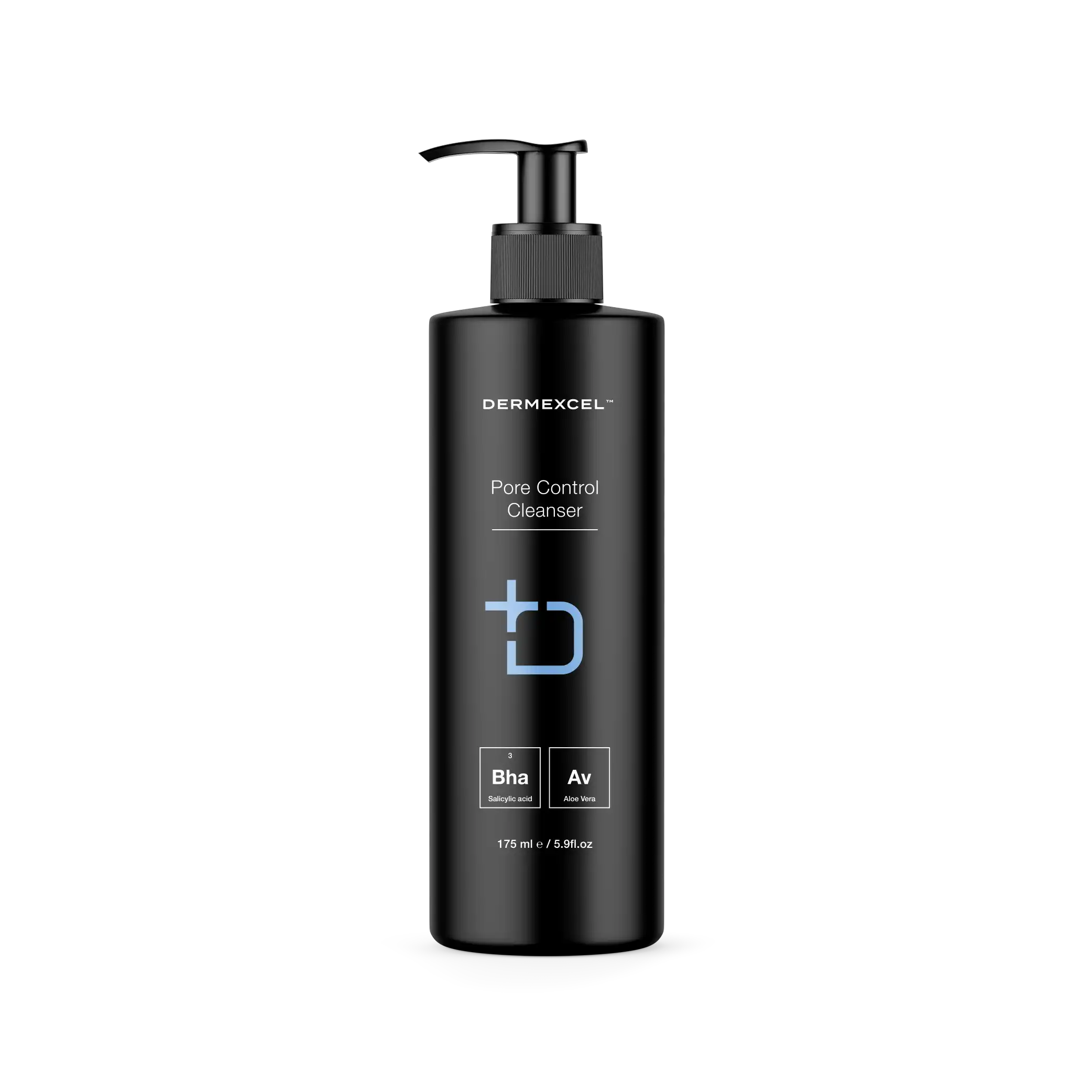
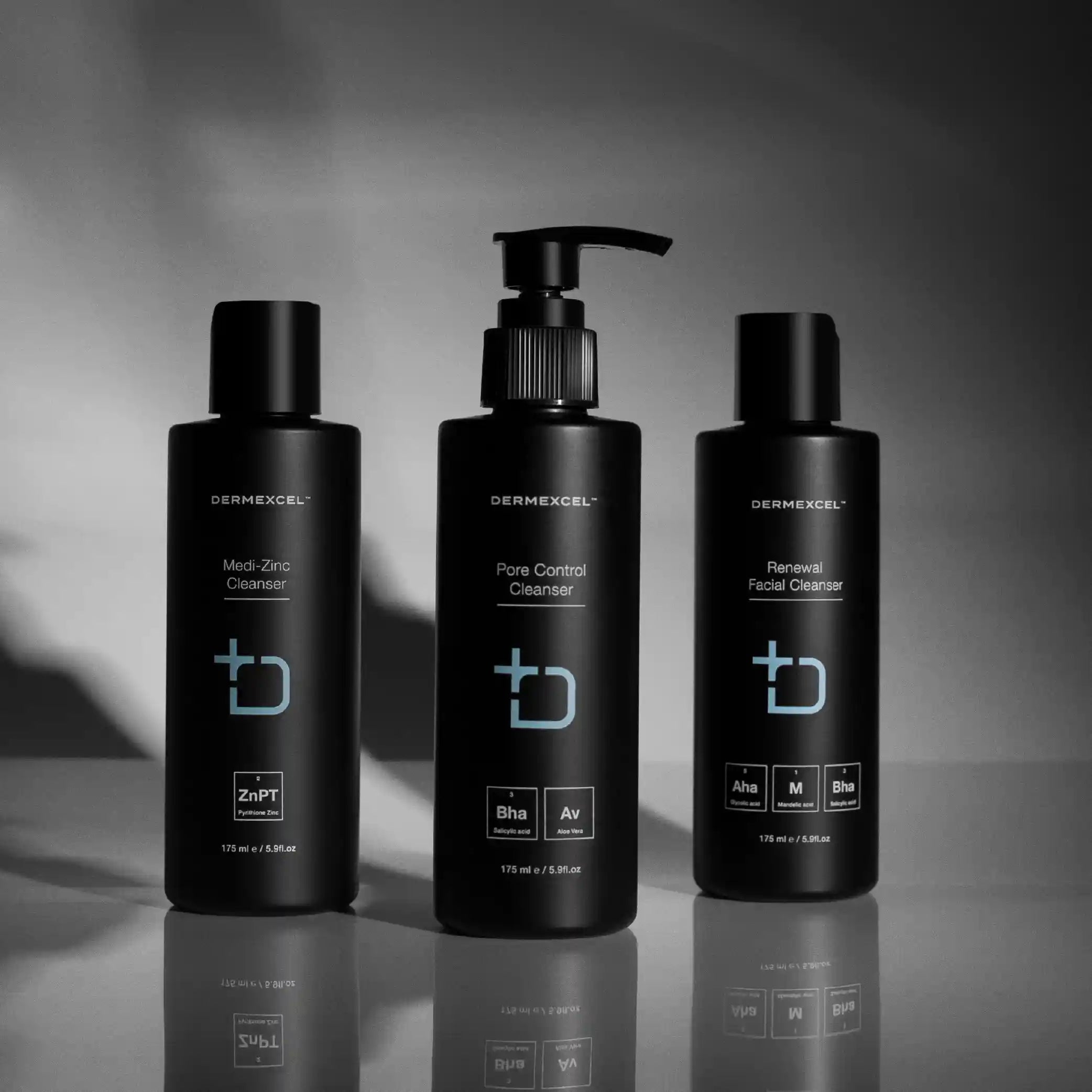
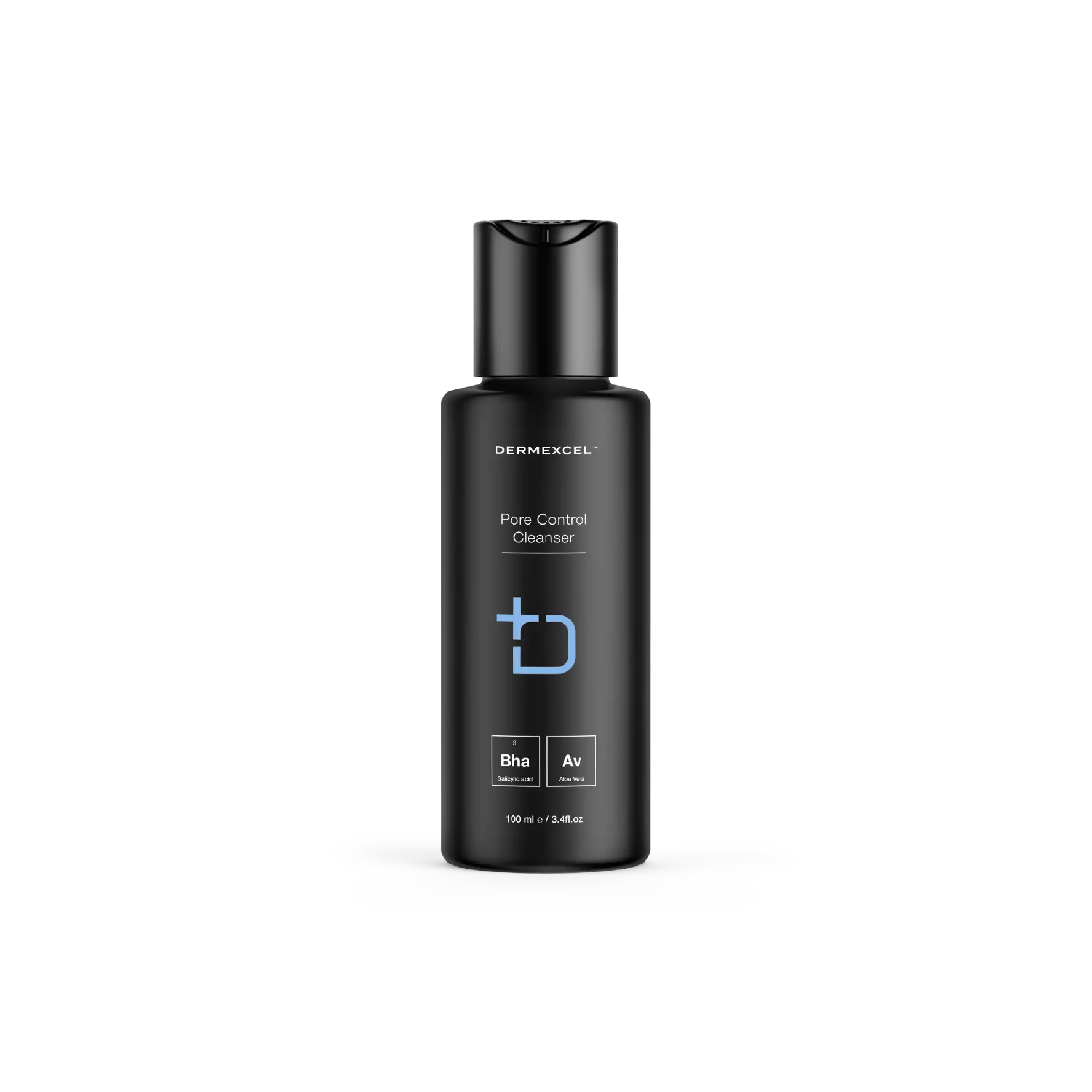





Unclog Pores

Minimize Pores

Anti-Acne

anti-redness

↓ inflammation
This scientifically formulated skincare solution regulates sebum production, thereby mitigating pore congestion. It employs a 3% concentration of Salicylic acid, a renowned anti-inflammatory agent, which diligently alleviates skin irritation and redness. This ingredient is also known for its potent anti-bacterial properties, effectively cleansing the skin of stubborn impurities.
A distinguishing feature of this cleanser is its inclusion of medical-grade Aloe Vera, a natural ingredient revered for its skin-nourishing capabilities. Aloe Vera imparts soothing and hydrating effects, particularly beneficial for skin dehydration due to other acne treatments.
Pore Control Cleanser is a balanced blend of scientifically proven ingredients that synergistically maintain skin health. It normalizes oil production, dislodges sebum plugs, reduces inflammation, and nourishes the skin, making it a comprehensive solution for maintaining a clear and healthy complexion.
Salicylic acid
Salicylic acid, a renowned beta hydroxy acid (BHA), is a cornerstone in dermatology and skincare due to its exceptional keratolytic and comedolytic properties. Its unique ability to penetrate oil-laden hair follicle pores makes it particularly effective in treating acne-prone and oily skin types.
Salicylic acid dissolves skin debris (sebum and dead skin cells) that clogs pores and causes acne. It's a mild antibacterial and powerful anti-inflammatory agent that helps reduce the redness and swelling associated with breakouts.
What sets salicylic acid apart in dermatological treatments is its ability to exfoliate the skin, not just on the surface but within the pores themselves. This is due to its oil-soluble nature, which allows it to penetrate deep into the pores and dissolve the keratin plugs that lead to blackheads and whiteheads.
Furthermore, salicylic acid also has the capacity to adjust the pH of the skin, creating an environment less favorable for the growth of acne-causing bacteria. Salicylic acid's efficacy in treating various skin conditions, particularly acne, has been extensively documented in the scientific literature. Studies have consistently shown its ability to reduce acne lesions in terms of count and severity. Additionally, salicylic acid is highly recommended for its effectiveness in treating other skin conditions, such as psoriasis and dandruff, due to its ability to soften and remove scales and flakes from the skin.
Physiological Effects
- Keratolytic Action: Salicylic acid is known for its ability to exfoliate the skin by dissolving the intercellular 'glue' that holds skin cells together, helping to remove dead skin cells and unclog pores.
- Comedolytic Effect: It is particularly effective in reducing comedones (blackheads and whiteheads) by unclogging pores and preventing the formation of new comedones.
- Anti-inflammatory Properties: Salicylic acid reduces inflammation, which is beneficial in treating acne and other inflammatory skin conditions.
- Sebum Regulation: It helps to regulate oil production, making it a valuable ingredient for managing oily and acne-prone skin.
- Penetration Enhancement: Due to its lipophilic nature, it can penetrate sebum-filled follicles, effectively treating acne located deep within the pores.
Managing Dermatological Conditions
- Acne Vulgaris: Salicylic acid is a cornerstone in acne treatment, effectively preventing and treating existing acne lesions.
- Psoriasis: Its keratolytic properties make it helpful in softening and removing scales associated with psoriasis.
- Warts: Salicylic acid is commonly used to treat warts because it can exfoliate and remove thick skin.
- Seborrheic Dermatitis: It helps manage seborrheic dermatitis by reducing scaling and redness.
- Keratosis Pilaris: Salicylic acid can aid in smoothing the rough bumps associated with peratosis Pilaris.
References
- Zaenglein, A. L., Pathy, A. L., Schlosser, B. J., Alikhan, A., Baldwin, H. E., Berson, D. S., & Thiboutot, D. M. (2016). Guidelines of care for the management of acne vulgaris. Journal of the American Academy of Dermatology, 74(5), 945-973.e33.
- Kornhauser, A., Coelho, S. G., & Hearing, V. J. (2010). Applications of hydroxy acids: classification, mechanisms, and photoactivity. Clinical, cosmetic and investigational dermatology, 3, 135.
- Zander, E., & Weisman, S. (1992). Treatment of acne vulgaris with salicylic acid pads. Clinical Therapeutics.
- Gupta, A. K., & Nicol, K. (2004). The use of sulfur in dermatology. Journal of Drugs in Dermatology.
Aloe Vera
Aloe vera is well-regarded for its medicinal applications and has been a staple in skincare and health for centuries. It’s rich in vitamins, enzymes, minerals, and amino acids, contributing to its many skin benefits.
Aloe vera contains polysaccharides, which are crucial in its moisturizing and anti-inflammatory properties. These polysaccharides help bind moisture to the skin, making aloe vera an excellent hydrating agent for dry and damaged skin.
One of the key benefits of aloe vera is its soothing and healing properties, particularly beneficial for burns, abrasions, and skin irritations. It has been shown to accelerate the healing of minor burns and reduce skin inflammation. Various studies have supported its effectiveness in treating first- and second-degree burns, highlighting its role in enhancing collagen synthesis and skin regeneration.
Aloe vera's anti-inflammatory properties are attributed to compounds like glycoproteins and polysaccharides. These compounds help reduce pain and swelling associated with skin irritations and wounds. Aloe vera also contains aloin and emodin, which provide analgesic, antibacterial, and antiviral properties, further extending its therapeutic potential.
Aloe Vera has numerous physiological effects on the skin due to its rich composition of vitamins, enzymes, minerals, and amino acids. The presence of antioxidants such as vitamins C and E, along with beta-carotene, contributes to its anti-aging benefits, helping to improve skin firmness and keep the skin hydrated.
Physiological Effects
- Moisturizing and Hydrating: Aloe Vera enhances skin hydration, making it effective for dry and dehydrated skin. Its mucopolysaccharides help to bind moisture into the skin.
- Wound Healing: It accelerates wound healing by enhancing collagen synthesis and cross-linking. This effect is particularly useful in healing burns, abrasions, and cuts.
- Anti-inflammatory Properties: Aloe Vera contains compounds like aloin and anthraquinones that have anti-inflammatory properties, making it beneficial in reducing skin inflammation.
- Antimicrobial Activity: It possesses antimicrobial properties, which help in preventing infections in wounds and burns.
- Antioxidant Properties: The presence of vitamins C and E and beta-carotene provides it with antioxidant properties, which can help protect the skin from free radical damage.
- Soothing Effect: Aloe Vera is known for its soothing effects on the skin, particularly in conditions like sunburn.
Managing Dermatological Conditions
- Burns and Wound Care: Aloe Vera's wound-healing and soothing properties make it effective in treating burns, including sunburns and minor skin abrasions.
- Acne Treatment: Due to its antimicrobial and anti-inflammatory properties, it can help treat acne.
- Eczema and Psoriasis: Its moisturizing, anti-inflammatory, and soothing properties are beneficial in managing symptoms of eczema and psoriasis.
- Aging Skin: Aloe Vera's antioxidant properties and ability to improve collagen production can help reduce the signs of aging.
- Skin Hydration: It's a common ingredient in moisturizers and other skin care products for its hydrating properties.
References
- Surjushe, A., Vasani, R., & Saple, D. G. (2008). Aloe vera: A short review. Indian Journal of Dermatology.
- Maenthaisong, R., Chaiyakunapruk, N., Niruntraporn, S., & Kongkaew, C. (2007). The efficacy of aloe vera used for burn wound healing: A systematic review. Burns.
- Rajeswari, R., Umadevi, M., Rahale, C. S., Pushpa, R., Selvavenkadesh, S., Kumar, K. S., & Bhowmik, D. (2012). Aloe vera: The miracle plant its medicinal and traditional uses in India. Journal of Pharmacognosy and Phytochemistry.

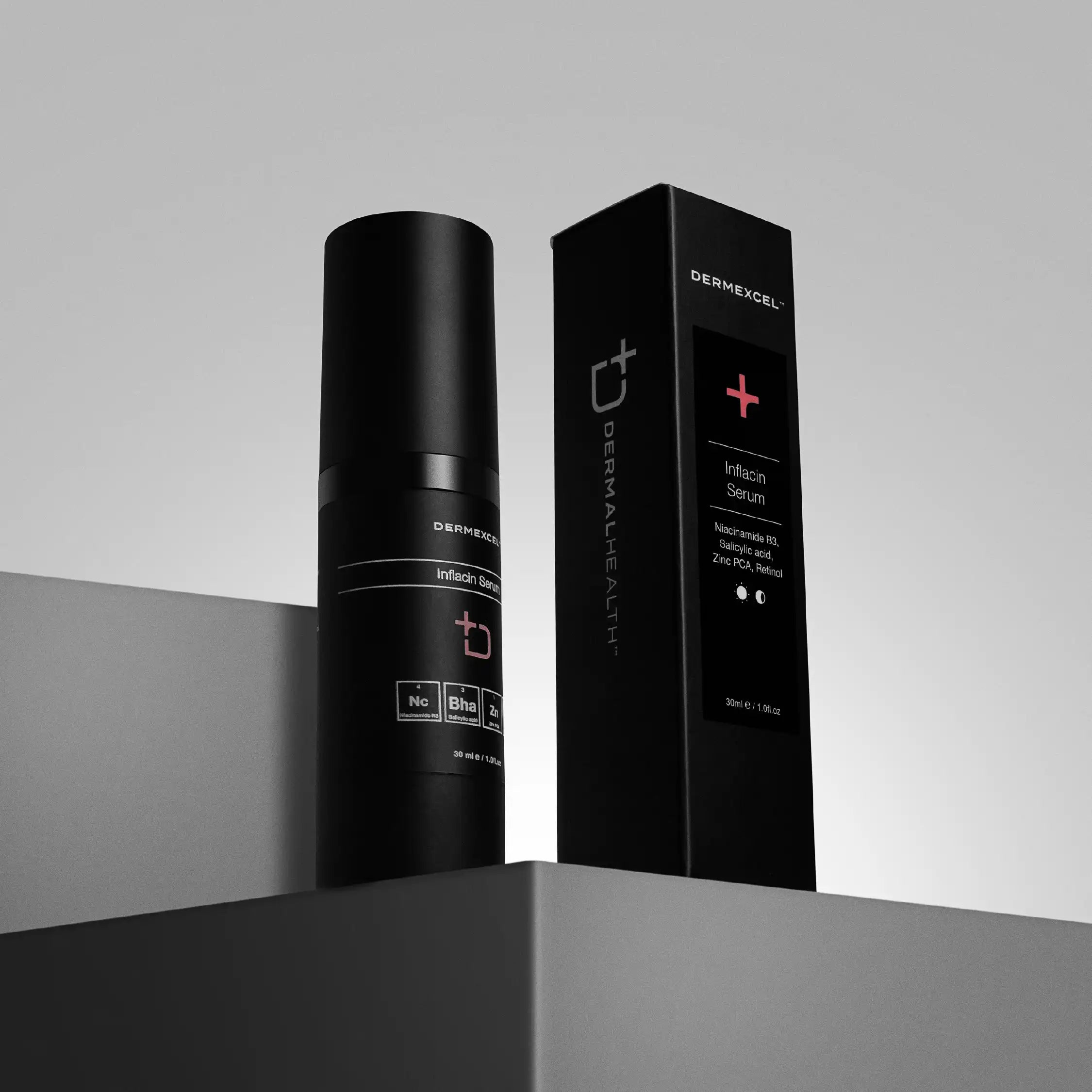




SIZE: 30 mL

Unclog Pores

↓ Sebum

Anti-Acne

↓ inflammation

anti-aging
A medical-grade treatment with a potent blend of anti-inflammatory and acne-combating ingredients to address skin issues in oily, acne-prone, and combination skin types. The formulation prioritizes preserving skin hydration while eliminating skin concerns like pimples and blackheads.
The serum's composition includes salicylic acid, known for its proficiency in unclogging pores and reducing acne-related inflammation. Zinc PCA is critical in regulating sebum production and minimizing oily skin complications. Niacinamide shrinks enlarged pores and alleviates inflammation related to acne and rosacea. Lastly, retinol stimulates cell turnover, aids in the fight against premature aging, and enhances overall skin texture and tone.
As a holistic approach, Inflacin Serum reduces current skin issues and aims to prevent future skin complications, thus promoting a healthier skin condition.
Niacinamide
Niacinamide offers several benefits for the skin, primarily due to its anti-inflammatory and antioxidant properties. It reduces the redness and inflammation associated with acne, rosacea, and other inflammatory skin conditions. Additionally, niacinamide's ability to improve the skin's barrier function benefits all skin types, particularly those with eczema or mature skin.
Another significant benefit of niacinamide is its role in reducing hyperpigmentation. Studies have shown that it can decrease the transfer of melanin to the epidermis, helping to fade dark spots and even out skin tone.
Niacinamide also plays a role in reducing the visible signs of aging. It has been found to stimulate collagen production and improve skin elasticity, reducing fine lines and wrinkles. Its antioxidant properties further protect the skin from environmental damage, such as pollution and UV radiation, which contribute to premature aging.
The efficacy of niacinamide and its ability to address multiple skin concerns simultaneously has led to its growing popularity in both over-the-counter and prescription skincare formulations.
Physiological Effects
- Barrier Function Enhancement: Niacinamide helps strengthen the skin’s barrier function by increasing the production of ceramides, lipids that keep the skin hydrated and protect against environmental damage.
- Anti-inflammatory Properties: It has notable anti-inflammatory effects, which are beneficial in reducing redness and inflammation associated with acne, eczema, and other inflammatory skin conditions.
- Sebum Regulation: Niacinamide helps regulate sebum production, which controls excess oiliness and can benefit acne-prone skin.
- Hyperpigmentation Reduction: It reduces hyperpigmentation by inhibiting melanosome transfer from melanocytes to keratinocytes, leading to an even skin tone.
- Anti-aging Effects: Niacinamide helps reduce the appearance of fine lines and wrinkles by boosting collagen production and improving skin elasticity.
- Antioxidant Activity: It has antioxidant properties, protecting the skin from oxidative stress and environmental aggressors like UV radiation and pollution.
Managing Dermatological Conditions
- Acne and Oily Skin: Niacinamide effectively manages acne and oily skin by regulating sebum and reducing inflammation.
- Hyperpigmentation and Melasma: Its ability to reduce melanin transfer benefits it in treating hyperpigmentation and melasma.
- Aging Skin: Niacinamide targets wrinkles and loss of firmness.
- Skin Barrier Disorders: Niacinamide is beneficial in treating skin barrier disorders like atopic dermatitis and eczema by enhancing barrier function and hydration.
- Photodamage and Skin Protection: It helps mitigate the effects of photodamage and provides some degree of protection against environmental damage.
References
- Gehring, W. (2004). Nicotinic acid/niacinamide and the skin. Journal of Cosmetic Dermatology.
- Bissett, D. L., Oblong, J. E., & Berge, C. A. (2005). Niacinamide: A B vitamin that improves aging facial skin appearance. Dermatologic Surgery.
- Snaidr, V. A., Damian, D. L., & Halliday, G. M. (2019). Nicotinamide for photoprotection and skin cancer chemoprevention: A review of efficacy and safety. Experimental Dermatology.
- Navarrete-Solís, J. et al. (2011). A Double-Blind, Randomized Clinical Trial of Niacinamide 4% versus Hydroquinone 4% in the Treatment of Melasma. Dermatology Research and Practice, 2011.
Salicylic acid
Salicylic acid, a renowned beta hydroxy acid (BHA), is a cornerstone in dermatology and skincare due to its exceptional keratolytic and comedolytic properties. Its unique ability to penetrate oil-laden hair follicle pores makes it particularly effective in treating acne-prone and oily skin types.
Salicylic acid dissolves skin debris (sebum and dead skin cells) that clogs pores and causes acne. It's a mild antibacterial and powerful anti-inflammatory agent that helps reduce the redness and swelling associated with breakouts.
What sets salicylic acid apart in dermatological treatments is its ability to exfoliate the skin, not just on the surface but within the pores themselves. This is due to its oil-soluble nature, which allows it to penetrate deep into the pores and dissolve the keratin plugs that lead to blackheads and whiteheads.
Furthermore, salicylic acid also has the capacity to adjust the pH of the skin, creating an environment less favorable for the growth of acne-causing bacteria. Salicylic acid's efficacy in treating various skin conditions, particularly acne, has been extensively documented in the scientific literature. Studies have consistently shown its ability to reduce acne lesions in terms of count and severity. Additionally, salicylic acid is highly recommended for its effectiveness in treating other skin conditions, such as psoriasis and dandruff, due to its ability to soften and remove scales and flakes from the skin.
Physiological Effects
- Keratolytic Action: Salicylic acid is known for its ability to exfoliate the skin by dissolving the intercellular 'glue' that holds skin cells together, helping to remove dead skin cells and unclog pores.
- Comedolytic Effect: It is particularly effective in reducing comedones (blackheads and whiteheads) by unclogging pores and preventing the formation of new comedones.
- Anti-inflammatory Properties: Salicylic acid reduces inflammation, which is beneficial in treating acne and other inflammatory skin conditions.
- Sebum Regulation: It helps to regulate oil production, making it a valuable ingredient for managing oily and acne-prone skin.
- Penetration Enhancement: Due to its lipophilic nature, it can penetrate sebum-filled follicles, effectively treating acne located deep within the pores.
Managing Dermatological Conditions
- Acne Vulgaris: Salicylic acid is a cornerstone in acne treatment, effectively preventing and treating existing acne lesions.
- Psoriasis: Its keratolytic properties make it helpful in softening and removing scales associated with psoriasis.
- Warts: Salicylic acid is commonly used to treat warts because it can exfoliate and remove thick skin.
- Seborrheic Dermatitis: It helps manage seborrheic dermatitis by reducing scaling and redness.
- Keratosis Pilaris: Salicylic acid can aid in smoothing the rough bumps associated with peratosis Pilaris.
References
- Zaenglein, A. L., Pathy, A. L., Schlosser, B. J., Alikhan, A., Baldwin, H. E., Berson, D. S., & Thiboutot, D. M. (2016). Guidelines of care for the management of acne vulgaris. Journal of the American Academy of Dermatology, 74(5), 945-973.e33.
- Kornhauser, A., Coelho, S. G., & Hearing, V. J. (2010). Applications of hydroxy acids: classification, mechanisms, and photoactivity. Clinical, cosmetic and investigational dermatology, 3, 135.
- Zander, E., & Weisman, S. (1992). Treatment of acne vulgaris with salicylic acid pads. Clinical Therapeutics.
- Gupta, A. K., & Nicol, K. (2004). The use of sulfur in dermatology. Journal of Drugs in Dermatology.
Zinc PCA
Zinc PCA, also known as Zinc Pyrrolidone Carboxylic Acid, is a skin care ingredient that combines the mineral zinc with a hydrating molecule PCA (Pyrrolidone Carboxylic Acid). It is renowned for its numerous benefits in skincare, particularly for its anti-inflammatory, antimicrobial, and sebum-regulating properties.
Zinc PCA is derived from zinc, an essential mineral known for its antioxidant and skin-soothing capabilities. Zinc is also noted for its role in wound healing and its ability to reduce inflammation, which can be particularly beneficial for acne-prone and irritated skin. The PCA component is a natural moisturizing factor (NMF) found in the skin, which helps maintain the skin's hydration levels.
One of the key benefits of Zinc PCA is its ability to regulate sebum production. Excess sebum can lead to acne and oily skin, and Zinc PCA helps to moderate this by inhibiting the activity of the enzyme 5-alpha reductase, which is involved in oil production. This makes it an effective ingredient in formulations targeting oily and acne-prone skin (Schueller, R. and Romanowski, P., 2003).
In addition to its sebum-regulating properties, Zinc PCA possesses antimicrobial properties, which further contribute to its efficacy in treating acne. By reducing the presence of acne-causing bacteria on the skin, it helps to prevent and reduce acne breakouts.
Moreover, Zinc PCA's anti-inflammatory properties make it beneficial for soothing irritated skin and reducing redness and inflammation associated with various skin conditions, including acne, rosacea, and eczema.
Physiological Effects
- Sebum Regulation: Zinc PCA reduce and regulate sebum secretion and production, making it beneficial for oily and acne-prone skin by controlling excess oil production.
- Antimicrobial Action: Zinc has antimicrobial properties, particularly effective against acne-causing bacteria, reducing acne breakouts.
- Anti-inflammatory Effects: Zinc PCA reduces inflammation, which is beneficial in treating inflammatory skin conditions like acne and rosacea.
- Moisture Retention: PCA is a natural moisturizing factor (NMF) that helps maintain skin hydration, enhancing the skin’s moisture retention capabilities.
- Wound Healing: Zinc is essential for wound healing processes, aiding in the repair and regeneration of skin tissues.
Managing Dermatological Conditions
- Acne Management: Its ability to regulate sebum production and provide antimicrobial action makes Zinc PCA a valuable ingredient in acne treatments.
- Oily Skin: It's beneficial in controlling excess oiliness and maintaining a balanced skin environment.
- Sensitive Skin Conditions: Due to its anti-inflammatory properties, Zinc PCA soothes sensitive skin and conditions like rosacea.
- Skin Hydration: Its role as an NMF helps in maintaining skin hydration, useful in treating dry skin conditions.
References
- Schagen, S. K., et al. (2012). Discovering the link between nutrition and skin aging. Dermato-endocrinology.
- Firooz, A., et al. (2011). Zinc therapy in dermatology: a review. Dermatology Research and Practice.
- Gupta, M., et al. (2014). Zinc therapy in dermatology. Indian Dermatology Online Journal.
- Schueller, R. and Romanowski, P. (2003). Conditioning Agents for Hair and Skin. Cosmetic Science and Technology Series. Marcel Dekker Inc., New York, USA.
Retinoic acid analogue
Retinoic acid, often referred to as tretinoin in its pharmaceutical form, is the active form of Vitamin A. It is widely recognized for its powerful effects in dermatology and skin care, particularly in treating acne and signs of skin aging.
Retinoic acid works at the cellular level to modify gene expression and affect cell growth. In treating acne, it promotes the turnover of skin cells, reducing the likelihood of pore-clogging and helping to clear existing breakouts. Additionally, it decreases the cohesiveness of follicular epithelial cells, further preventing the formation of comedones.
Retinoic acid's ability to stimulate collagen production is a key benefit in anti-aging skincare. This leads to a reduction in fine lines and wrinkles and an improvement in overall skin texture and tone. It also aids skin discoloration and hyperpigmentation by accelerating cell turnover, bringing new skin cells to the surface faster, and shedding pigmented and damaged cells.
Despite its benefits, retinoic acid can irritate the skin, causing side effects like redness, dryness, and peeling, especially during the initial period of use. Its potency means it is generally available by prescription and requires careful monitoring by a healthcare professional.
Hydroxypinacolone Retinoate (HPR) is a newer, esterified form of retinoic acid. Unlike cosmetic retinol, HPR binds directly to the retinoid receptors of the skin cells without needing conversion. This direct binding allows it to deliver similar benefits to retinoic acid, such as stimulating collagen production, improving skin elasticity, and reducing signs of aging, but with a lower risk of irritation.
HPR is considered more gentle and less irritating than traditional retinoic acid while offering comparable benefits. With HPR, everyone has access to the benefits of prescription retinoids without the risk of side effects.
Physiological Effects
- Cell Turnover and Renewal: HPR promotes rapid cell turnover, aiding in the exfoliation of dead skin cells and generating new cells.
- Skin Texture: Promoting cell renewal improves skin texture and addresses issues like roughness and dullness.
- Collagen Production: It stimulates collagen production, which is essential for reducing the appearance of fine lines and wrinkles and improving skin elasticity.
- Acne Treatment: Effective in treating acne by unclogging pores and reducing the size of sebaceous glands, it diminishes both inflammatory and non-inflammatory acne lesions.
- Pigmentation: It can reduce hyperpigmentation by accelerating the turnover of hyperpigmented skin cells and inhibiting melanin production.
- Photoaging: Effective in treating signs of photoaging, reversing some of the damage caused by UV radiation.
Special Benefits
- Retinoid Receptor Activity: HPR, an ester of retinoic acid, binds directly to retinoid receptors in the skin, enabling it to work without needing to be converted into retinoic acid.
- Lower Irritation: Typically, it causes less irritation than retinoic acid, making it more suitable for sensitive skin types.
- Collagen Stimulation and Anti-Aging: Like retinoic acid, HPR helps in stimulating collagen production and has anti-aging properties.
- Acne and Hyperpigmentation: It effectively treats acne and reduces hyperpigmentation, often with fewer side effects than retinoic acid.
- Stability and Penetration: HPR is more stable and lipid-soluble, so it penetrates the skin more effectively and is less prone to degradation.
References
- Zaenglein, A. L., Pathy, A. L., Schlosser, B. J., Alikhan, A., Baldwin, H. E., Berson, D. S., ... & Thiboutot, D. M. (2016). Guidelines of care for the management of acne vulgaris. Journal of the American Academy of Dermatology, 74(5), 945-973.e33.
- Fisher, G. J., Wang, Z. Q., Datta, S. C., Varani, J., Kang, S., & Voorhees, J. J. (1996). Pathophysiology of premature skin aging induced by ultraviolet light. New England Journal of Medicine, 337(20), 1419-1428.
- Truchuelo, M. T., Jiménez, N., Jaén, P. (2018). Assessment of the efficacy of a new complex-based retinoic acid and retinol in a 3-month study using objective methods and skin biomarker analysis. Journal of Cosmetic Dermatology, 17(3), 347-354.
- Mukherjee, S., et al. (2006). Retinoids in the treatment of skin aging: an overview of clinical efficacy and safety. Clinical Interventions in Aging.
- Randhawa, M., et al. (2015). Hydroxypinacolone retinoate: a new retinoid and its use in dermatology. Skin Therapy Letter.
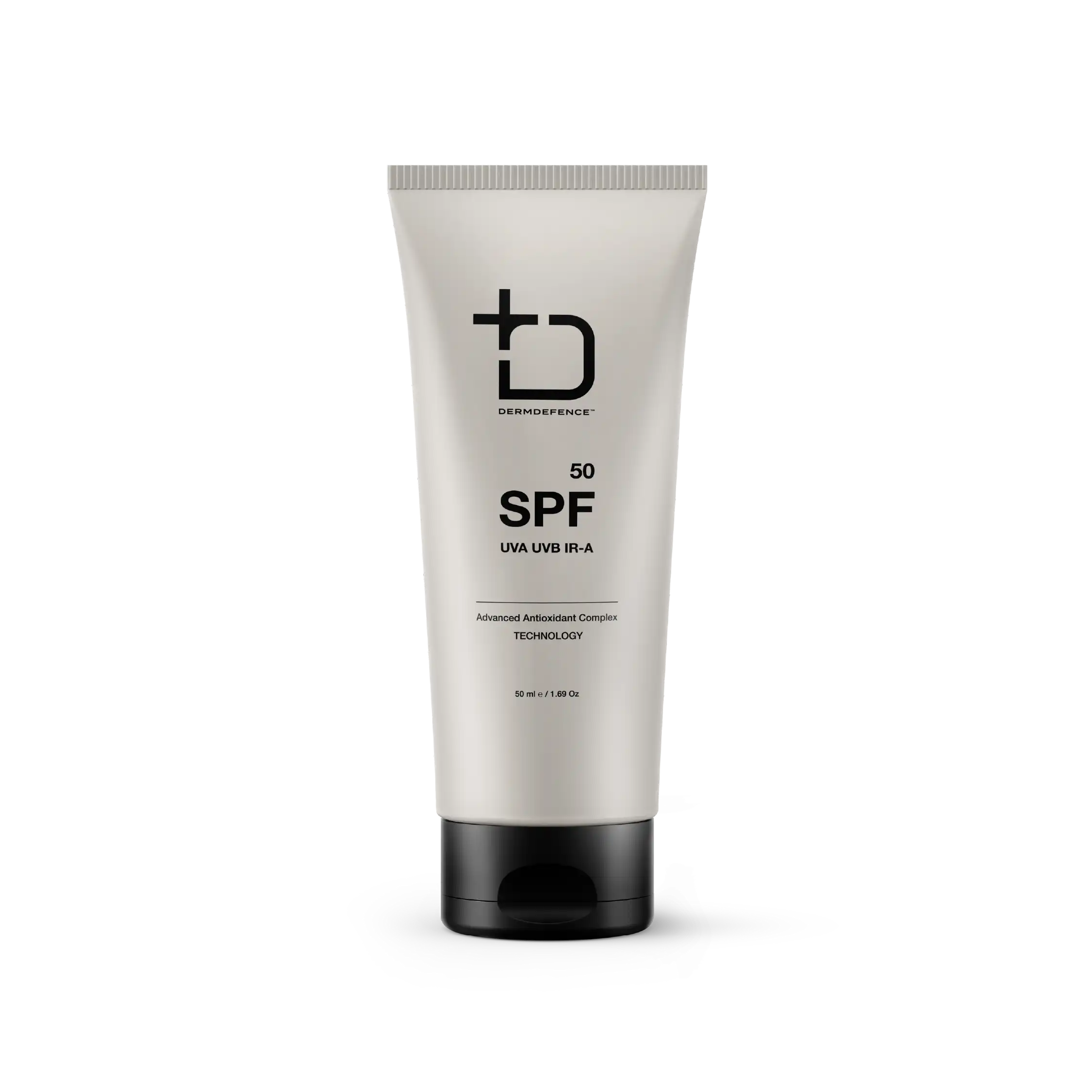
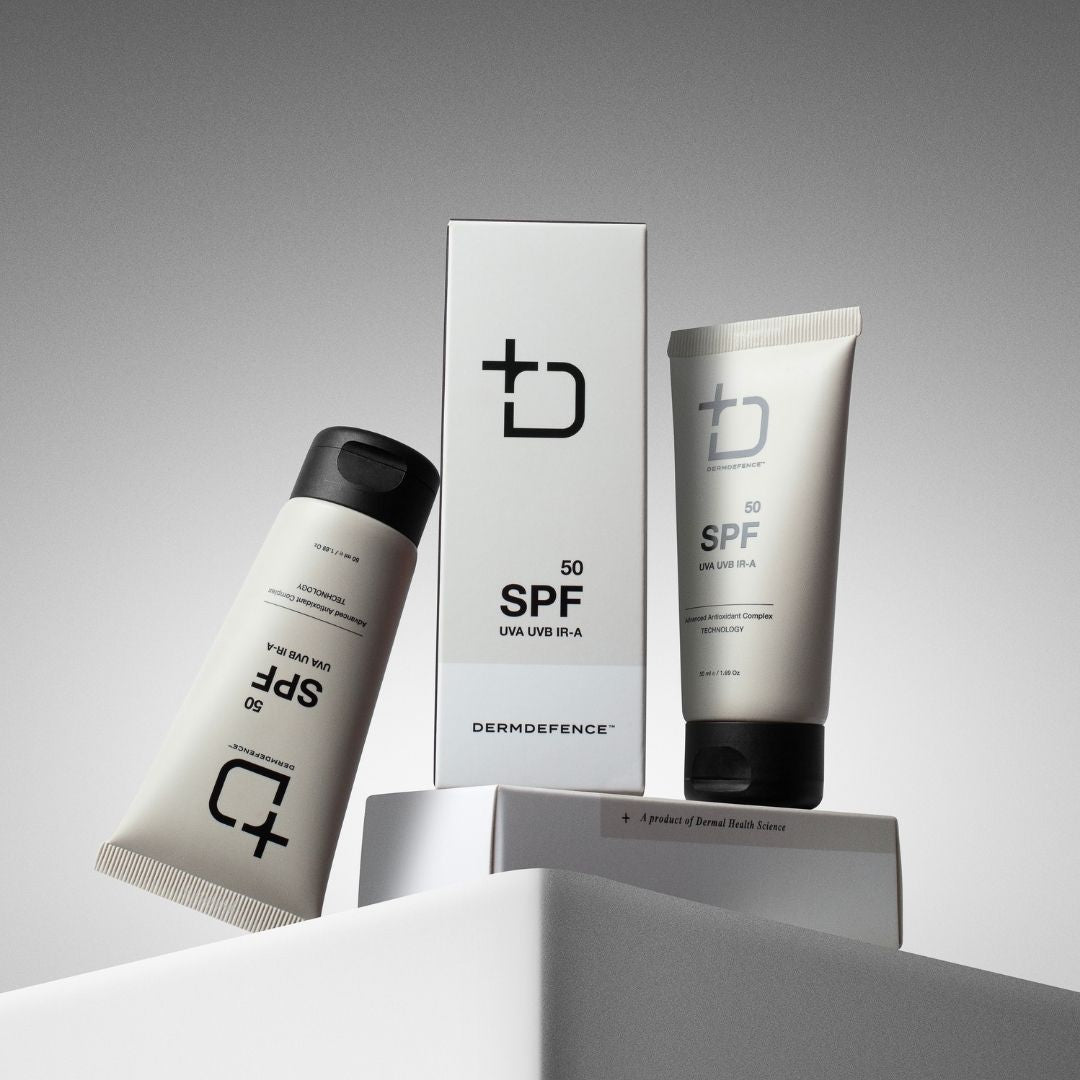




SIZE: 50 mL

Antioxidant

anti-aging

DNA repair

sun protection

Moisturizing
A pioneering sunscreen offering superior protection against the sun while preserving your skin's cellular and DNA health. The innovative formula exceeds standard UV protection, guarding against UVA, UVB, damaging infrared rays, and blue light. Offering wide-ranging protection bolsters your skin's restorative abilities, promoting a healthier and more resilient complexion.
Designed to be fragrance-free and anti-comedogenic, Dermdefence SPF 50 ensures no skin irritation or pore clogging, making it an excellent choice for those with skin conditions like Acne, Rosacea, or Eczema. Its lightweight, non-greasy texture provides easy application and rapid absorption, without leaving a white cast.
Dermdefence SPF 50 also serves as a primer, providing a smooth finish for easy makeup application and ensuring a flawless look all day. Dermdefence SPF 50 provides unparalleled sun protection that will shield your skin and nurture its unique needs, maintaining its health and radiance.
Coenzyme Q10
CoQ10 is a potent ingredient that offers comprehensive skin health and appearance benefits. Its role in energy production and its antioxidant and anti-aging properties make it invaluable for photoprotection, anti-aging, and overall skin vitality. Its incorporation into DermExcel sunscreen represents a holistic approach to skin health, addressing protective and restorative needs.
Physiological Impact
- Skin Barrier Enhancement: CoQ10 contributes to the strength and health of the skin barrier, improving its ability to retain moisture and protect against external irritants and pollutants.
- Skin Repair and Regeneration: It supports the skin's natural ability to repair itself and regenerate, maintaining a healthy, youthful appearance. This is particularly beneficial in mature skin, where natural levels of CoQ10 may be depleted.
Pharmacological Advantages
- Anti-Aging Effects: CoQ10's antioxidant properties contribute to its anti-aging effects. By reducing oxidative stress, it helps to minimize the visible signs of aging, such as wrinkles and fine lines.
- Photoprotection: It enhances the skin's defense against photoaging caused by exposure to UV rays. CoQ10 helps to mitigate the degradation of collagen and elastin, proteins essential for maintaining skin elasticity and firmness.
Biochemical Benefits
- Cellular Energy Production: CoQ10 plays a crucial role in the mitochondrial electron transport chain, which is essential for the production of ATP, the primary energy currency of the cell. This function is vital for maintaining the health and vitality of skin cells.
- Antioxidant Properties: It acts as a lipophilic antioxidant, neutralizing free radicals and preventing oxidative damage to cell membranes, proteins, and DNA. This is particularly important in the skin, which is frequently exposed to oxidative stress from environmental factors like UV radiation.
Infraguard™
Infraguard™ is a novel and powerful antioxidant powerhouse designed to protect the skin from the potentially harmful effects of electromagnetic radiation, specifically from 5G networks, blue light, and other environmental stressors. It shields the skin against oxidative stress and inflammation, prevents premature aging, and maintains overall health.
Infraguard® is a multifunctional ingredient that extends beyond traditional sun protection. It addresses the broader spectrum of light-induced skin damage and oxidative stress, provides DNA protection, and offers anti-aging benefits. Its inclusion in the DermExcel sunscreens represents an advanced step in comprehensive skin care, targeting UV rays and the often-overlooked infrared and blue light, ensuring a more holistic approach to maintaining skin health and appearance.
Physiological Effects
- Protection Against Blue Light and Infrared (IR) Radiation: Infraguard is formulated to shield the skin from the harmful effects of blue light and IR radiation, which can lead to premature skin aging and damage.
- Antioxidant Properties: It has strong antioxidant capabilities, helping to neutralize free radicals induced by environmental stressors such as pollution, IR, and blue light.
- Anti-Aging Benefits: By protecting against IR radiation and mitigating oxidative stress, Infraguard helps to prevent signs of aging like wrinkles and loss of skin elasticity.
- Skin Barrier Protection: Infraguard strengthens the skin's natural barrier, enhancing its resilience against environmental factors.
- DNA Protection: Infraguard™ aids in shielding the DNA in skin cells from damage caused by environmental aggressors. This is crucial in maintaining the integrity of skin cells and preventing mutations that can lead to skin aging and other skin-related issues.
Managing Dermatological Conditions
- Preventing Photoaging: Infraguard's ability to protect against IR and blue light makes it beneficial in preventing photoaging, a key concern in modern dermatology. Infrared light can penetrate deeper into the skin than UV rays, potentially leading to increased collagen degradation and skin laxity. Infraguard® helps mitigate these effects.
- Combatting Environmental Stressors: Its antioxidant properties protect the skin from various environmental pollutants and stressors.
- Supporting Skin Health: Infraguard contributes to overall skin health by improving the skin's barrier function and providing antioxidant support.
- Suitability for Diverse Skin Conditions: Given its protective and anti-aging properties, Infraguard is suitable for use in various dermatological conditions, especially environmental damage and aging.
References
- Kappler, Katharina et al. "Development of an in Vitro Assay to Evaluate the Biological Impact of 5G Technology on Human Skin. Journal of Cosmetics, Dermatological Sciences and Applications, 2022, vol. 12, pp. 100-108. DOI: 10.4236/jcdsa.2022.122009.
- Extensive references cited within the research article including studies on 5G technology, health effects, and skin biology.
Broad Spectrum Filters
Tinosorb® M and Tinosorb® S represent sophisticated advancements in sun protection technology.
Tinosorb® M
- Biochemical Action: A unique UV filter due to its ability to function through absorption, reflection, and scattering of UV rays.
- Physiological Impact: The triple-action mechanism of Tinosorb® M offers comprehensive sun protection. By mitigating the penetration of both UVA and UVB rays, it significantly reduces the risk of DNA damage, photoaging, and carcinogenesis. Its ability to remain on the skin's surface reduces systemic exposure, making it a safer option with minimal potential for irritation or allergic reactions.
Tinosorb® S
- Biochemical Action: A broad-spectrum UV filter with a molecular structure that effectively absorbs both UVA and UVB rays. Additionally, it enhances the photostability of other UV filters, making the sunscreen formulation more effective over time.
- Physiological Impact: By providing extensive UVA and UVB protection, Tinosorb® S plays a crucial role in preventing short-term sun damage like sunburn and long-term risks such as skin aging and skin cancer. Its photostability ensures sustained protection during sun exposure, and its compatibility with other UV filters means it can be used to formulate sunscreens that are both effective and suitable for sensitive skin.
Sunscreen
Using sunscreen is a fundamental aspect of skin care and preventive dermatology. It's essential for reducing the risk of skin cancers and photoaging and maintaining overall skin health in the face of constant exposure to UV radiation.
Sunscreen is a vital skincare product designed to protect the skin from the harmful effects of ultraviolet (UV) radiation from the sun. Two primary types of UV radiation affect the skin: UVA and UVB. UVA rays penetrate deep into the skin and are primarily responsible for aging and long-term skin damage, whereas UVB rays cause sunburn and play a key role in developing skin cancer.
Sunscreen products work by either absorbing, reflecting, or scattering sunlight. They contain chemical compounds that absorb UV radiation and convert it into a small amount of heat or physical compounds (like zinc oxide or titanium dioxide) that act as a physical barrier, reflecting UV light away from the skin.
The effectiveness of sunscreen is measured by its Sun Protection Factor (SPF). SPF indicates how well the sunscreen protects against UVB rays. For example, an SPF of 30 means it would take 30 times longer for your skin to burn than without sunscreen. However, it's important to note that no sunscreen can block 100% UV rays.
Regular use of sunscreen with an SPF of at least 30 can reduce the risk of skin cancer, prevent sunburn, and slow down the skin's aging process.
Managing Dermatological Conditions
Prevention of Sunburn
- UVB Protection: Sunscreen protects the skin from UVB rays, which cause sunburn. This reduces the immediate risk of skin damage and discomfort.
Skin Cancer Prevention
- Reduces Risk of Skin Cancers: Regular use of sunscreen significantly lowers the risk of developing various types of skin cancer, especially melanoma, squamous cell carcinoma, and basal cell carcinoma.
Prevention of Photoaging
- UVA Protection: Sunscreen also shields the skin from UVA rays, which penetrate deeper into the skin and are primarily responsible for photoaging, including wrinkles, leathery skin, and sunspots.
Protection Against Photosensitivity
- Essential for Sensitive Skin Conditions: Sunscreen helps prevent flare-ups triggered by sun exposure for individuals with photosensitive skin conditions like lupus or rosacea.
Hyperpigmentation and Melasma
- Even Skin Tone: It aids in preventing and managing hyperpigmentation and melasma, conditions exacerbated by sun exposure.
General Skin Health
- Maintains Skin Health: Sunscreen helps maintain overall skin health and integrity by protecting the skin from UV damage.
References
- Burnett, M. E., & Wang, S. Q. (2011). Current sunscreen controversies: a critical review. Photodermatology, Photoimmunology & Photomedicine.
- Green, A. C., et al. (2011). Reduced melanoma after regular sunscreen use: randomized trial follow-up. Journal of Clinical Oncology.
- Hughes, M. C. B., et al. (2013). Sunscreen and Prevention of Skin Aging: A Randomized Trial. Annals of Internal Medicine.
Testimonials
My skin is smoother, breakouts have decreased significantly, and the recovery is also faster when I do get pimples. I’m just still struggling with hyperpigmentation, I’m looking forward to trying products that target it soon.
My son had severe folliculitis all over his head. After dermatologist visits, and dermatologist recommended products, not to mention the extreme costs involved, it just got worse!
I don't recall how I stumbled across Dermalhealth, but this product was life changing!
Within a week, his scalp was completely clear, and it remains completely clear!
I will never stop purchasing this product for him !
It helped with my folliculitis
My daughter struggled with her skin, having small white spots on her face.
Well that is now in the past, thank you to dermal health.
Works exceptionally well. Excellent products. Will definitely recommend all Dermalhealth's products.
Shaving Treatment Pack: Severe Bumps & Ingrown hair







